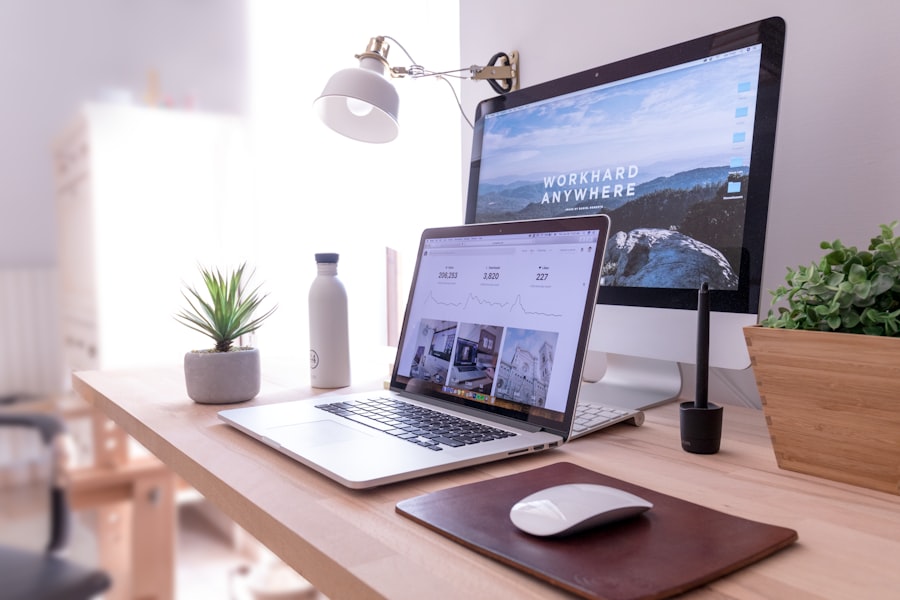Work-life balance is a concept that has gained significant attention in recent years as the demands of work and personal life continue to intersect. It refers to the equilibrium between the time and effort allocated to work and the time and energy dedicated to personal life, family, and leisure activities. Achieving work-life balance is essential for maintaining overall well-being, reducing stress, and enhancing productivity.
It involves managing responsibilities at work and at home in a way that allows individuals to fulfill their professional obligations while also having time for personal pursuits and relationships. In today’s fast-paced and technology-driven world, achieving work-life balance has become increasingly challenging. The constant connectivity and accessibility enabled by technology have blurred the boundaries between work and personal life, making it difficult for individuals to switch off from work and fully engage in leisure activities.
As a result, many people struggle to find the right balance between their professional and personal lives, leading to burnout, decreased job satisfaction, and strained relationships. However, with the right strategies and tools, it is possible to navigate the complexities of modern life and achieve a harmonious work-life balance.
Key Takeaways
- Work-life balance is the equilibrium between professional and personal life, allowing individuals to effectively manage both aspects.
- Technology has both positive and negative impacts on work-life balance, as it enables flexibility but also blurs the boundaries between work and personal life.
- Various tools and apps are available to help individuals manage their work-life balance, including time management apps, communication tools, and wellness apps.
- Remote work and flexible schedules have become increasingly popular, offering employees the opportunity to better balance their work and personal commitments.
- Setting boundaries and disconnecting from work during personal time is crucial for maintaining a healthy work-life balance and preventing burnout.
The Impact of Technology on Work-Life Balance
The “Always-On” Mentality
The widespread use of smartphones, email, and messaging apps has led to an “always-on” mentality, where employees feel pressured to be constantly available and responsive. This can take a toll on mental health and well-being, as individuals struggle to disconnect from work and maintain a healthy work-life balance.
The Blurred Lines of Remote Work
The rise of remote work and flexible schedules, made possible by technology, has further blurred the boundaries between work and personal life. While these arrangements offer greater flexibility and autonomy, they also make it difficult for individuals to establish clear boundaries and switch off from work during non-working hours.
Taking Control of Digital Boundaries
It is essential for individuals to recognize the impact of technology on their work-life balance and take proactive steps to manage their digital boundaries and prioritize self-care. By setting clear boundaries and learning to disconnect from work, individuals can maintain a healthy work-life balance and reduce the risk of stress and burnout.
Tools and Apps for Managing Work-Life Balance

Fortunately, there are a variety of tools and apps available to help individuals manage their work-life balance in today’s tech-driven world. Time management apps such as Toggl and RescueTime can help individuals track their time spent on work tasks and identify areas where they can improve efficiency. These tools can provide valuable insights into how time is allocated throughout the day and help individuals make informed decisions about how to prioritize their tasks.
Additionally, communication and collaboration platforms such as Slack and Microsoft Teams can facilitate efficient communication and streamline workflow, reducing the need for constant back-and-forth emails and enabling more focused work time. These tools can help individuals stay organized and connected with their colleagues while also setting clear boundaries around when they are available for work-related communication. Furthermore, mindfulness and wellness apps such as Headspace and Calm can support individuals in managing stress and promoting mental well-being.
These apps offer guided meditation, relaxation techniques, and sleep aids to help individuals unwind and recharge after a busy day. By incorporating these tools into their daily routine, individuals can cultivate a greater sense of balance and resilience in the face of work-related stressors.
Remote Work and Flexible Schedules
Remote work and flexible schedules have become increasingly prevalent in today’s workforce, offering employees the opportunity to work from home or adjust their hours to better accommodate personal responsibilities. While these arrangements can provide greater autonomy and flexibility, they also present unique challenges when it comes to maintaining work-life balance. Without the clear boundaries of a traditional office setting, individuals may find it difficult to disconnect from work and establish a healthy separation between their professional and personal lives.
However, with the right strategies in place, remote work and flexible schedules can be conducive to achieving work-life balance. Setting clear expectations with employers and colleagues regarding availability and communication can help individuals establish boundaries and create dedicated time for personal pursuits. Additionally, creating a designated workspace within the home can help individuals mentally separate their work environment from their living space, promoting a sense of balance and structure.
Moreover, establishing a consistent daily routine and schedule can help individuals maintain a sense of normalcy and structure, even when working remotely. By setting specific start and end times for work, as well as incorporating regular breaks and leisure activities into their day, individuals can create a sense of rhythm and balance that supports their overall well-being.
Setting Boundaries and Disconnecting
Setting boundaries and disconnecting from work is essential for maintaining work-life balance in a technology-driven world. It is important for individuals to establish clear guidelines around when they are available for work-related communication and when they are off the clock. This may involve setting specific “no-work” hours during evenings or weekends, as well as communicating these boundaries to colleagues and supervisors.
Additionally, creating physical boundaries within the home environment can help individuals mentally separate their work space from their personal space. This could involve designating a specific room or area for work activities, as well as establishing rituals or routines that signal the transition from work to leisure time. Furthermore, practicing digital detoxing by limiting screen time and unplugging from devices during non-working hours can help individuals create space for relaxation and rejuvenation.
This may involve turning off email notifications, silencing work-related apps, or even taking periodic breaks from social media to reduce digital distractions. By setting clear boundaries and disconnecting from work when off-duty, individuals can create a healthier balance between their professional responsibilities and personal life, reducing stress and promoting overall well-being.
The Role of Technology in Mental Health and Wellness

Access to Mental Health Resources
While technology has undoubtedly contributed to the blurring of boundaries between work and personal life, it also holds great potential for supporting mental health and wellness. There is a growing number of mental health apps and online resources that offer support for managing stress, anxiety, and other mental health challenges. These apps provide access to therapy, counseling, self-help tools, and educational resources that can empower individuals to take control of their mental well-being.
Monitoring Physical and Mental Health
Additionally, wearable technology such as fitness trackers and smartwatches can help individuals monitor their physical activity, sleep patterns, and stress levels, providing valuable insights into their overall health. By leveraging these tools, individuals can gain a better understanding of how their lifestyle habits impact their well-being and make informed decisions about how to prioritize self-care.
Telehealth Services for Mental Health Support
Moreover, telehealth services have become increasingly accessible, allowing individuals to connect with healthcare providers remotely for mental health support. This can be particularly beneficial for those who may have difficulty accessing traditional in-person care or prefer the convenience of virtual appointments.
The Future of Work-Life Balance in a Tech-Driven World
As technology continues to evolve at a rapid pace, the future of work-life balance will be shaped by innovative solutions that aim to mitigate the negative impact of constant connectivity on well-being. Employers are increasingly recognizing the importance of supporting their employees’ work-life balance through initiatives such as flexible scheduling, remote work options, and wellness programs. Furthermore, advancements in artificial intelligence (AI) and automation have the potential to streamline workflow processes and reduce the burden of repetitive tasks on employees, freeing up time for more meaningful work and personal pursuits.
Additionally, AI-powered tools may offer personalized insights into productivity patterns and stress triggers, enabling individuals to make informed decisions about how to optimize their work habits for greater balance. Moreover, as society becomes more attuned to the importance of mental health awareness, there is a growing emphasis on destigmatizing mental health challenges in the workplace. Employers are increasingly investing in mental health resources and support for their employees, recognizing that a healthy workforce is essential for long-term success.
In conclusion, achieving work-life balance in a technology-driven world requires proactive strategies, clear boundaries, and mindful use of digital tools. By leveraging technology for time management, communication, wellness support, and mental health resources, individuals can navigate the complexities of modern life while prioritizing their overall well-being. As we look towards the future, it is essential for employers, employees, and technology developers to collaborate in creating a work culture that values balance, resilience, and holistic well-being in an increasingly tech-driven world.
If you’re looking to improve your work-life balance through technology, you may want to consider investing in a new PC that can help you work more efficiently. This article on what to look for in a new PC provides valuable insights into the features and specifications you should consider when purchasing a new computer for your work or personal use. By choosing the right technology tools, you can streamline your work processes and free up more time for your personal life.
FAQs
What is work-life balance?
Work-life balance refers to the equilibrium between the time and effort spent on work and personal life. It involves effectively managing responsibilities at work and at home to lead a fulfilling and satisfying life.
How does technology impact work-life balance?
Technology has both positive and negative impacts on work-life balance. On one hand, it allows for flexibility in work hours and location, making it easier to juggle work and personal responsibilities. On the other hand, it can also lead to an “always-on” mentality, blurring the boundaries between work and personal life.
What are some ways technology can help achieve work-life balance?
Technology can help achieve work-life balance by enabling remote work, flexible work hours, and efficient communication. It also provides tools for time management, task organization, and stress reduction.
What are the potential drawbacks of relying on technology for work-life balance?
Relying too heavily on technology for work-life balance can lead to burnout, decreased productivity, and negative impacts on mental health. It can also create a dependency on constant connectivity, making it difficult to fully disconnect from work.
How can individuals use technology to improve their work-life balance?
Individuals can use technology to improve their work-life balance by setting boundaries for work hours and personal time, utilizing productivity tools to manage tasks efficiently, and taking advantage of remote work options when possible. It’s also important to be mindful of screen time and to prioritize self-care.



